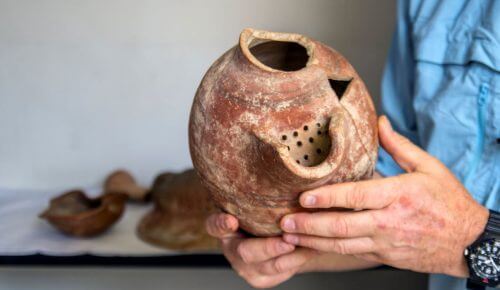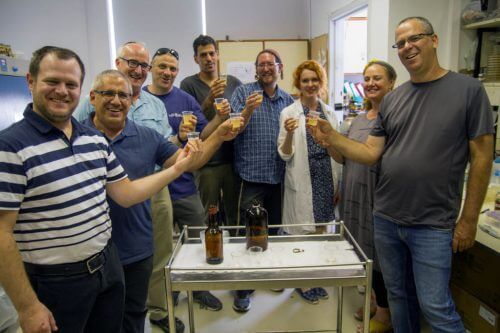What beer did Pharaoh, the king of Egypt, like to drink? A study carried out by researchers from the Hebrew University, the Antiquities Authority, Tel-Aviv University, Bar-Ilan University, found a unique method to isolate yeast from ancient pottery in order to produce beers of good quality. Dr. Ronan Hazan from the Hebrew University and Dr. Yitzhak Paz from the Antiquities Authority are among the leaders of the research: "We know what the flavors of Philistine and Egyptian beer were"

What beer did Pharaoh, the king of Egypt, like to drink? Already in the time of the ancient world, beer was an important component of the daily diet, and great power was attributed to it, especially for the purposes of religious worship and healing. The pottery, in which the beers were made in ancient times, was the basis of the new research. The leaders of the research, researchers Dr. Ronan Hazan and Dr. Michael Klotstein - microbiologists from the Faculty of Dentistry at the Hebrew University, who are usually engaged in medical research, used yeasts that formed colonies and established themselves in the pores of the pottery and tried to test how they are preserved over the years. Using the same yeast, high-quality, drinkable beers were finally produced.
In the first part of the research, which was carried out in several stages, the researchers were helped by the Kadama Winery from Kfar Oriya and proved that it is possible to isolate yeast from pottery, by immersing them in an unfiltered beer solution, even after being kept in the sun for two years. The yeast isolated by the researchers was photographed by Dr. Ziona Ben-Gadalia from Mizrah Regional Research and Development and Ariel University using a scanning electron microscope. After this initial examination, the researchers wanted to try and deepen the research and contacted the archaeologists Dr. Yitzhak Paz from the Antiquities Authority, Prof. Aharon Meir from Bar-Ilan University and Prof. Yuval Gadot and Prof. Oded Lifshitz from Tel Aviv University, who provided them with authentic pottery from tools identified as tools Beer and tamad (honey wine) are ancient.

The collection of vessels selected were from different periods in history, from 3,000 BC to the fourth century BC, from the founding of the first united Egyptian kingdom during the reign of King Narmer to the days of King Hazel of Aram and the days of Nehemiah, the governor of Judah under Persian rule. The tools were taken from various sites such as Ein-Bashur in the Negev, rescue excavations on Hamsgar Street in Tel Aviv and the university excavations in Tel Tzfit and Ramat Rachel. At this stage of the research, the student Zemach Ouzirat was able to isolate yeast from six different pots. When the researchers set out to characterize the yeasts by fully sequencing their DNA and analyzing it with the help of Dr. Amir Schittenberg from the Desert and Dead Sea Research and Development Center, it was found that the yeasts isolated from the ancient beer vessels are similar to those isolated from traditional beers produced in Africa, as well as modern beer yeasts.
In the last step, the researchers produced beers from the isolated yeasts with the help of beer expert Itai Gutman. After production, these were tested in a chemical analysis of flavor and aroma substances by Dr. Elashiv Drori from Ariel University and by a team of certified tasters from the International Beer Tasters Organization BJCP led by Shmuel Nakai. The tests revealed that the beers are of good quality and drinkable. Moreover, to the surprise of the researchers, in addition to the beer vessels, they also managed to isolate a considerable number of yeasts from ancient clay candles, which apparently derive from olive oil, a finding that strengthened the assumption that colonies of yeast are able to establish themselves for many years in pottery vessels.
Dr. Ronan Hazan from the Hebrew University, one of the leaders of the research, says that "the great wonder here is that the yeast colonies survived inside the dishes, were fermented in them for thousands of years, and were just waiting for us to take them out and grow them. Through them we were able to produce the beer and now we know what the tastes of the Philistine beer and the Egyptian beer were. By the way, they are not bad at all. Beyond the gimmick of Pharaoh king of Egypt or Acish king of Gath drinking beer, this research has great importance for the field of experimental archaeology, a field that tries to reconstruct the past. Our research offers new tools for examining methods, quality and allows us all to taste the taste of ancient food products."
Dr. Yitzhak Paz from the Antiquities Authority emphasizes the importance of the discovery: "We are talking about a real breakthrough here, this is the first time we have been able to produce ancient alcohol from ancient yeasts, that is, from the original materials from which the alcohol was produced, this has never been done before."
Prof. Yuval Gadot, from the Department of Archeology and Ancient Near Eastern Cultures at Tel Aviv University: "We excavated at Ramat Rachel, the largest Persian site in the Kingdom of Judah, and found a large concentration of jars with the letters XNUMX, XNUMX, XNUMX written on them - Yehud. In a royal place like Ramat Rachel it makes sense that there would be alcohol consumption, a place where the Persian commissioner sat."
Prof. Aharon Meir, from the Department of Land of Israel Studies and Archeology at Bar-Ilan University: "The findings shed light on the biblical image of the Philistines drinking their wine."

One response
magnificent! Can you imagine pouring authentic beer in the souvenir shop of an archaeological site? And that's in addition to the usual goods of goofball hats, fridge magnets and postcards (yes, there are still postcards out there).
I'm already looking forward to archeology nights in the pub.